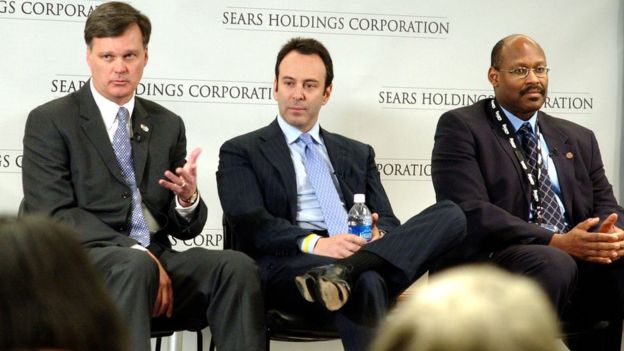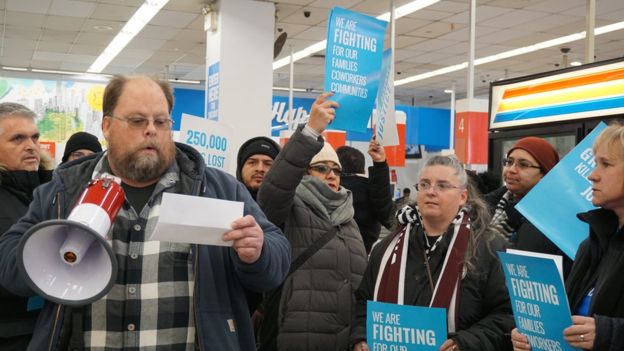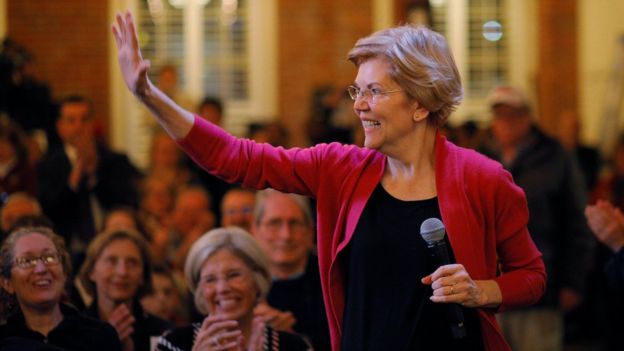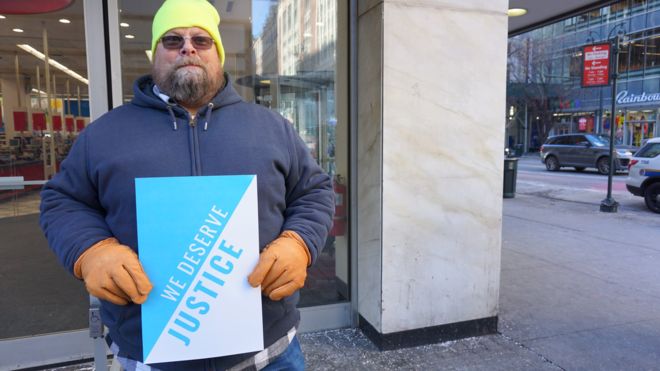As a wave of bankruptcies hits the retail sector, workers want to know why their bosses are coming out ahead.
The fall of Sears, once an icon of American retail might, has hit Bruce Miller hard.
The 56-year-old started at the department store out of high school, rising to be a senior auto technician.
But since Sears closed his New Jersey location last April, he has lost his health insurance and his house. Now his pension is at risk.
For Mr Miller’s bosses, however, fortunes look brighter.
Veteran journalist Michelle Celarier has estimated that longtime Sears chairman and former chief executive Eddie Lampert has made nearly $1.4bn (£1.1bn) off his investment in the company, thanks to performance fees, dividends and other payments.
Meanwhile, its top 340 executives were collectively granted a potential $25m in bonuses in December, just months after the firm declared bankruptcy.
“It’s utterly ridiculous to me,” says Mr Miller, who is now relying on odd jobs to help pay bills. “How can you reward somebody for driving a business into the ground?”
‘The real story’

Laments like Mr Miller’s have surfaced repeatedly in recent years, amid a wave of bankruptcies in the US retail sector that has claimed household names such as Toys R Us, Payless Shoe Source and Nine West.
Much of the blame has focused on the disruption caused by online shopping.
But analysts say many of the firms have another feature in common: investors who took control of the retailers, loaded them with debt, and extracted fees, dividends and other assets for their own benefit.
Sears, for example, spent millions purchasing its own stock – inflating prices in a win for shareholders such as Mr Lampert, who became chair of the firm in 2005, after arranging its merger with Kmart.
Sears later borrowed more than $2bn from his hedge fund, ESL Investments, as it struggled to remain in operation.
It also sold off parts of the business, including hundreds of properties and the mail-order catalogue Lands End, to companies affiliated with Mr Lampert.
Sears is now a shadow of its former self, having closed almost 3,000 stores and cut more than 250,000 jobs since 2007.

Eileen Appelbaum, co-director of the Center for Economic and Policy Research in Washington, says those deals limited Sears’ ability to invest in the future – just as the need to compete with online shopping made those investments critical.
That is a pattern seen repeatedly in the recent retail failings, she said.
“They want to blame everything that happens on Amazon,” she says. “The fact that they have starved these organisations of resources … that’s the real story.”
‘Years-long scheme’
ESL has defended its actions, saying “all transactions were done in good faith, on fair terms” in order to keep Sears in business.
It said it was confident that its process for reviewing deals for conflicts of interest was “unimpeachable”.
The firm is now offering to buy Sears out of bankruptcy for $5.2bn.
The plan could keep 425 stores open and retain up to 45,000 jobs.

But several groups owed money have asked the court to reject the proposal, which is funded in part by forgiving some debt owed to his hedge fund.
They cite concerns like those of Ms Appelbaum and Mr Miller’s.
“ESL’s current bid to ‘save’ the company is nothing but the final fulfilment of a years-long scheme to deprive Sears and its creditors of assets and its employees of jobs while lining Lampert’s and ESL’s own pockets,” attorneys for a group of unsecured creditors wrote.
‘Apply pressure’
Outside court, Senator Elizabeth Warren, a Democratic presidential candidate, has weighed in with similar questions, as have Sears workers.
At a rally in New York this month, they accused Mr Lampert of driving the firm to failure and asked the court to require that money be set aside for workers in the event of future layoffs, among other demands.
“We want to apply pressure in a big way,” Mr Miller says. “Somebody’s going to have to say, ‘Hey, wait a minute, we’ve got to fix this situation.'”
A similar campaign by Toys R Us workers last summer successfully shamed former private equity owners KKR and Bain Capital into creating a $20m severance fund.
But that was an exception, contingent on those firms’ largesse.

Analysts said bankruptcy judges are often reluctant to challenge plans that would keep a business open – even in cases with as many potential conflicts of interest as Sears.
Meanwhile, the Trump administration has taken a hands-off regulatory approach, even as issuance of loans to firms with weak credit soars to record levels, driven by strong investor demand for debt.
Carrie Gleason, who helped organise the worker campaigns as a policy director for Organization United for Respect, says the Toys R Us bankruptcy marked a “breaking point” for broader awareness of the way business strategies contributed to retailer failings.
But with retail’s struggles expected to continue, more pressure is needed to bring change, Ms Gleason says.
“This is not going to be the last [bankruptcy],” she says.
“They’re going to keep coming and ultimately what we need are some new protections.”

